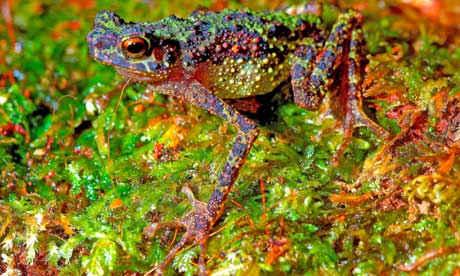
The Sambas stream toad, or Bornean rainbow toad.
The first ever photographs of rediscovered "rainbow toad" last seen over four decades ago have been released by scientists exploring the mountains of Borneo.
In recent years, the Washington-based Conservation International placed the Sambas stream toad, also known as the Bornean rainbow toad, on a world "top 10 most wanted lost frogs" and voiced fears it might be extinct.
Researchers found three of the slender-limbed toads living on trees during a night search last month in a remote mountainous region of Malaysia's eastern Sarawak state in Borneo, said Indraneil Das, a conservation professor at the Sarawak Malaysia University who led the expedition.
Only illustrations of the toads previously existed, drawn from specimens collected by European explorers in the 1920s. Das said his team first decided to seek the toad last August, but months of searching proved fruitless until they went higher up the Penrissen mountain range, which has rarely been explored in the past century.
"It is good to know that nature can surprise us when we are close to giving up hope, especially amid our planet's escalating extinction crisis," Robin Moore, a specialist on amphibians at Conservation International, said in a statement announcing the discovery.
The toads found on three separate trees measured up to 5.1cm in length and comprised an adult male, an adult female and a juvenile, the statement said.
Das declined to reveal the exact site of his team's discovery because of fears of illegal poaching due to strong demand for bright-hued amphibians. Researchers will continue work to find out more about the Borneo rainbow toad and other amphibians in Penrissen.
Conservationists say many endangered animals in Borneo are threatened by hunting and habitat loss sparked by logging, plantations and other human development.


Post a Comment